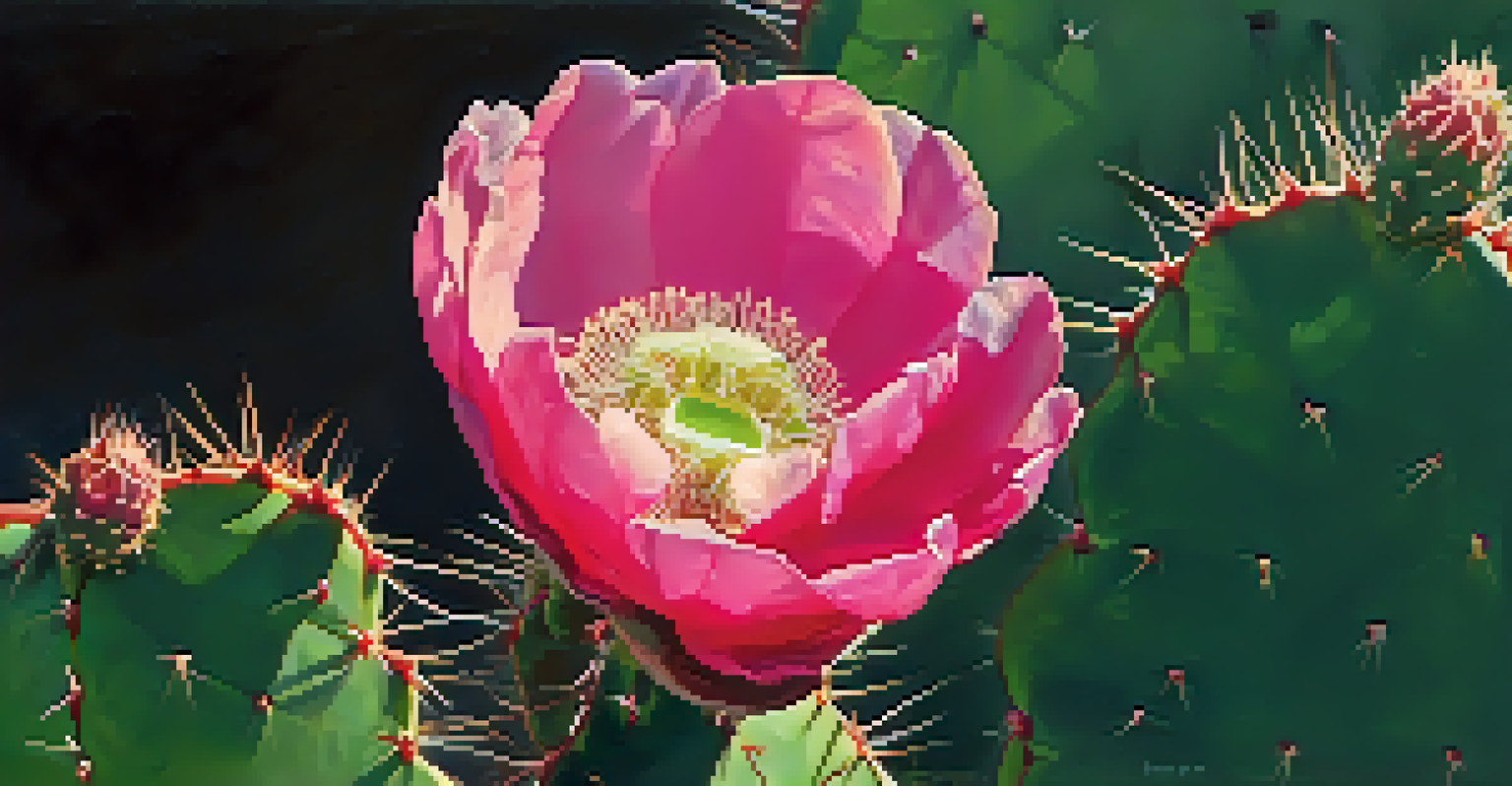Tucson's Cacti: Biodiversity and Their Ecological Importance

The Cacti of Tucson: A Unique Biodiversity Hotspot
Tucson, Arizona, is home to a remarkable variety of cacti, making it one of the most biodiverse regions in the United States. From the majestic saguaro to the vibrant prickly pear, these plants are not just beautiful; they play a crucial role in the ecosystem. The diversity of species found here is a result of the unique desert climate and geography, which have fostered adaptations over millennia.
In every walk with nature one receives far more than he seeks.
Each cactus species has its own unique characteristics and adaptations that allow it to thrive in the harsh desert environment. For instance, the saguaro can grow to be over 40 feet tall and live for over 150 years, showcasing its resilience. Meanwhile, the smaller barrel cactus stores water efficiently, ensuring its survival during dry spells.
This incredible biodiversity contributes to the overall health of the desert ecosystem. The variety of cacti provides food and shelter for numerous animal species, creating a delicate balance that sustains life in the arid landscape.
Cacti: The Lifeblood of Tucson's Ecosystem
Cacti are not just solitary plants; they are integral to the ecosystem of Tucson. They provide essential resources such as food and habitat for wildlife, including birds, insects, and mammals. For example, the saguaro's flowers attract pollinators like bees and bats, which are vital for the reproduction of many plant species.

Moreover, cacti play a significant role in soil health. Their roots help prevent erosion by stabilizing the soil, while their decomposing organic matter enriches the ground, promoting a thriving environment for other plants. This symbiotic relationship highlights the interconnectedness of desert life.
Cacti: Essential for Ecosystem Health
Cacti provide vital resources and habitat for wildlife, playing a crucial role in maintaining the balance of Tucson's desert ecosystem.
In essence, cacti are the backbone of Tucson's desert ecosystem. They not only support a diverse range of wildlife but also contribute to the overall health and sustainability of the environment.
The Cacti's Role in Water Conservation
In a desert climate like Tucson, water conservation is critical, and cacti are masters of this art. These plants have evolved specialized structures to minimize water loss, such as thick, waxy skins and reduced leaf surfaces. This adaptation allows them to thrive in an environment where rainfall is scarce.
The clearest way into the Universe is through a forest wilderness.
Additionally, many cacti have deep root systems that can reach groundwater, ensuring they can access moisture even during prolonged dry periods. This capability not only benefits the cacti but also supports other plants and animals that rely on the limited water resources available.
By understanding and appreciating how cacti conserve water, we can learn valuable lessons about sustainability and resource management. Their strategies can inspire conservation efforts in other ecosystems, highlighting the importance of adapting to environmental challenges.
Cacti: A Source of Food and Medicine
Cacti have been a source of sustenance for both wildlife and humans for centuries. Many species, such as the prickly pear, produce edible fruits and pads that are rich in nutrients. These fruits are not only a tasty treat but also an important food source for various animals, including birds and small mammals.
In addition to their nutritional value, certain cacti have medicinal properties. Indigenous peoples have traditionally used cacti for various remedies, from treating digestive issues to skin ailments. The knowledge of these uses is passed down through generations, highlighting the cultural significance of these plants.
Water Conservation Masters
Cacti have evolved unique adaptations that allow them to conserve water effectively in Tucson's arid climate.
Embracing the culinary and medicinal potential of cacti can lead to innovative practices in sustainable agriculture and health. As interest in native plants grows, so does the opportunity to explore their benefits in modern diets and natural remedies.
The Threats Facing Tucson's Cacti
Despite their resilience, Tucson's cacti face numerous threats that jeopardize their survival. Urban development, climate change, and invasive species are significant challenges that disrupt their natural habitats. As cities expand, cacti populations are often displaced, leading to a loss of biodiversity.
Climate change poses another critical risk, altering rainfall patterns and increasing temperatures. These changes can stress cactus populations, making them more susceptible to diseases and pests. Moreover, invasive species can outcompete native cacti for resources, further diminishing their numbers.
Conserving Tucson's cacti requires collective action and awareness. By understanding the threats they face, we can advocate for protective measures and support conservation initiatives aimed at preserving these iconic plants.
Conservation Efforts for Cacti in Tucson
Recognizing the importance of cacti for the ecosystem, various conservation efforts are underway in Tucson. Organizations and local communities are working together to protect native species and their habitats. Initiatives include habitat restoration, public education, and the establishment of protected areas.
Educational programs aim to raise awareness about the ecological significance of cacti and encourage sustainable practices among residents. By fostering a sense of stewardship, these programs empower individuals to take part in conservation efforts.
Cultural and Medicinal Importance
Cacti hold significant cultural value and offer nutritional and medicinal benefits, highlighting their importance to both wildlife and human communities.
Through collaboration and community engagement, Tucson can safeguard its unique cacti for future generations. These efforts not only benefit the plants themselves but also enhance the overall health and beauty of the desert landscape.
The Cultural Significance of Cacti in Tucson
Cacti hold deep cultural significance for the people of Tucson, especially Indigenous communities. These plants are often featured in traditional art, stories, and rituals, symbolizing resilience and adaptability in the face of adversity. Their presence in cultural practices highlights the connection between people and the land.
Moreover, cacti are becoming increasingly popular in modern landscaping and design, reflecting a growing appreciation for native flora. This trend not only enhances the aesthetic appeal of urban spaces but also promotes biodiversity and environmental stewardship.

By celebrating the cultural importance of cacti, Tucson can strengthen its identity and foster a deeper connection between its residents and the natural world. This appreciation can inspire future generations to honor and protect these iconic plants.